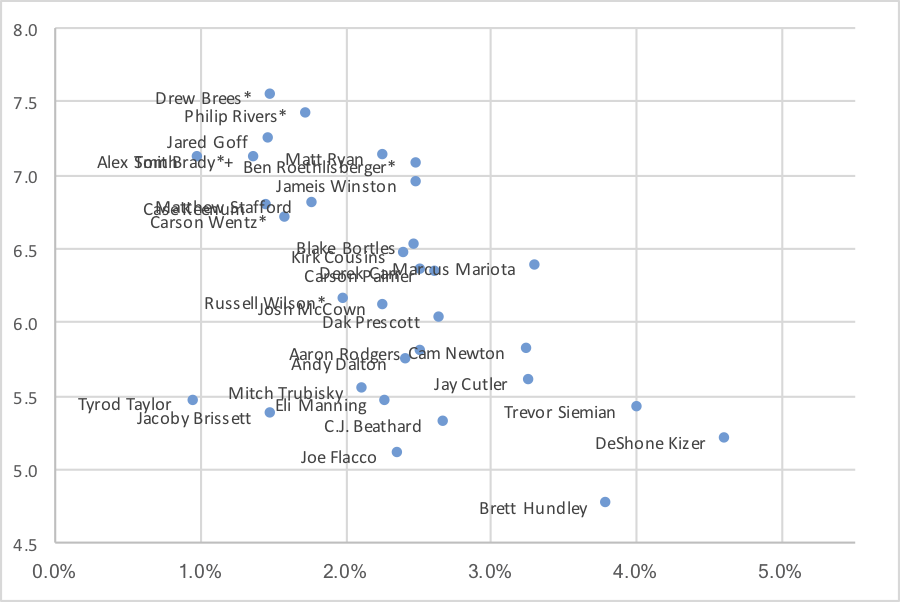Something was missing from the 2017 season: a quarterback who threw a lot of interceptions but also threw for a lot of yards. At a basic level, you might assume that these two statistics would be inversely related. After all, a bad quarterback would throw a lot of interceptions and not throw for a lot of yards, while a good quarterback shouldn’t throw many interceptions but should throw for a lot of yards.
But in a competitive environment, such absolutes rarely hold up. Some quarterbacks will have to be aggressive to be effective (high average yards per pass but also a high interception rate), while some will choose to be conservative (low average yards per pass but also a low interception rate). But in 2017, we missed that. For example:
- The three passers with the worst interception rates also ranked in the bottom six in net yards per pass attempt: DeShone Kizer, Trevor Siemian, and Brett Hundley were just bad, not aggressive.
- Marcus Mariota ranked had the 4th worst (i.e., highest) interception rate and ranked 14th in net yards per attempt. By 2017 standards, that stands out as aggressive.
- The quarterbacks who 5th-through-8th in interception rate all ranked below-average in net yards per attempt. Again, these quarterbacks were not necessarily very aggressive, just not very good.
- Ben Roethlisberger (12th worst interception rate, 7th best net yards per attempt average), Derek Carr (10th, 15th), Blake Bortles (14th, 12th), and Jameis Winston (13th, 8th) join Mariota as the only passers to rank in the bottom 15 in interception rate and top 15 in net yards per attempt.
Conversely, Tom Brady, Jared Goff, Drew Brees, and Alex Smith all had very low interception rates and very high net yards per attempt averages, with all four ranking in the top 7 of both metrics. Philip Rivers ranked 2nd in NY/A and 9th in interception rate. Case Keenum ranked 4th in interception rate and 10th in NY/A.
Really, the only two outliers when it came to great interception rates were Tyrod Taylor (1st in interception rate, 25th in NY/A) and Jacoby Brissett (tied for 6th in interception rate, 28th in NY/A).
The chart below shows the 32 qualifying passers in 2017. The Y-Axis displays net yards per attempt; the X-Axis displays interception rate. You’ll notice a lack of any dots in the upper right section of the graph, which is where the very aggressive passers would go:

Here’s the full version which includes player labels:

In the comments to Wednesday’s interesting guest post post from Adam Steele, a lot of discussion centered on Lynn Dickey and his unusual 1983 season. Dickey had the worst interception rate of any passer that year at 6.0%, but he also averaged an insanely high 7.92 net yards per attempt. Dan Fouts led the league at 8.10 NY/A, but 1983 Fouts and 1983 Dickey both ranked at the time in the top 5 of all passers since the merger in net yards per pass attempt.
In 1980, Steve Grogan led all passers with an atrocious 7.2% interception rate; Fouts led the NFL in NY/A at 7.25 by the narrowest of margins: Grogan averaged 7.24 net yards per attempt that season.
In 2000, Kurt Warner was one of just three passers to have an interception rate north of 5.0%; the other two were Troy Aikman (in the final season of his career) and Ryan Leaf (in an averaged Ryan Leaf season). Meanwhile, Warner set a post-merger record by averaging 9.03 net yards per pass attempt, a mark that hasn’t been challenged since.
To recap: This season, zero quarterbacks ranked in the top 10 in net yards per attempt and in the bottom 10 in interception rate (with more interceptions placing a quarterback closer to the bottom). Mariota, Roethlisberger, and Winston stand out, to me, as the most aggressive passers, but really none were particularly aggressive by historical standards.
As recently as 2016, Ryan Tannehill and Philip Rivers each ranked in the top 10 in NY/A and bottom 10 in interception rate; in 2015, Roethlisberger and Winston did it (Roethlisberger ranked in the top 3/bottom 3 in a particularly notable gunslinger type of season); in 2014, Mark Sanchez in 8 starts with the Eagles qualified.
In 2013, Andy Dalton was top 10/bottom 10. Josh Freeman and Tony Romo did it in 2012, Carson Palmer and Rivers in 2011, and Eli Manning, Jon Kitna, and Brees in 2010.
I’m not so sure that the lack of a gunslinger in 2017 is a trend, but I do think teams are too focused on avoiding interceptions. Even Roethlisberger, who was perhaps the second most aggressive passer this season by these two stats, threw 5 of his 14 interceptions in one game!
That said, there may still be hope in the form of Deshaun Watson. The Texans rookie averaged 7.10 NY/A this season, the same as Brady and Smith. But he also had a 3.9% interception rate, which would have ranked 3rd in the NFL had he qualified. He was also responsible for the gunslinger game of the year: against the Seahawks, he threw 3 interceptions but averaged 13.4 yards per attempt; he is joined by two Hall of Famers as the only passers in the last 30 years to average 12+ yards per attempt in a game where he threw 3+ interceptions. Watson started just six games in 2017, but he was responsible for just 2 of the 7 games in 2017 where a passer threw 2+ interceptions and averaged 9.0+ yards per attempt on 15+ attempts.
So maybe the gunslinger didn’t disappear in 2017; maybe he only got hurt.
